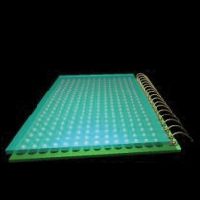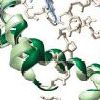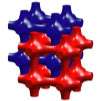Gruner Group Research
[exit
frames]
NOTE:
This page is old. To really see what we do visit the
Publications page.
Lab Research Summary
[.pdf
462
kb]
 Pixel Array Detector (PAD): [PAD homepage] The PAD group focuses on
the development of CMOS based x-ray detectors for x-ray
science experiments. Since CMOS is a highly developed
integrated circuit platform that has benefitted from
prolonged development in private industry, it offers
finely tuned, ever-advancing, technology that can be
exploited for the construction of cutting-edge x-ray
sensors. The advancement of science using x-ray scattering
and radiogrpahy is fundamentally dependent on the
capabilities of the detectors used and it is therefore
difficult to over estimate the importance of pixel array
detectors. Pixel Array Detector (PAD): [PAD homepage] The PAD group focuses on
the development of CMOS based x-ray detectors for x-ray
science experiments. Since CMOS is a highly developed
integrated circuit platform that has benefitted from
prolonged development in private industry, it offers
finely tuned, ever-advancing, technology that can be
exploited for the construction of cutting-edge x-ray
sensors. The advancement of science using x-ray scattering
and radiogrpahy is fundamentally dependent on the
capabilities of the detectors used and it is therefore
difficult to over estimate the importance of pixel array
detectors.
Examples of projects in the PAD group include a detector
for ultrafast microsecond x-ray imaging; large dynamic
range detectors for macromolecular protein crystallography
developed in partnership with industry; and a project to
develop a detector for single molecule scattering
experiments to be performed with X-ray Free Electron Laser
(XFEL)
at the Linac Coherent Light Source (LCLS).
[1] The next great leap in X-ray Science (Alper
Ercan, Matt Renzi, Mark W. Tate)
[.pdf 410Kb / Cornell Press Release, 26th Feb 2002 /
Cornell Chronicle Article, 7th March 2002]
 Proteins under Pressure: Proteins are
nature’s own molecular machines that perform a dizzying
array of tasks within every living cell. Their operation
is determined by intra and inter-molecular forces that are
not yet well understood. Pressure modifies those basic
molecular interactions and has a marked effect on
organisms and their proteins. Lysozyme unfolds at high
pressure just as it would if heated; eggs cook at high
pressure with no heat. Yellow Fluorescent Protein changes
its fluorescence spectrum when pressurized. High pressure
cooling of protein crystals causes them to diffract better
than they would if flash frozen. Proteins under Pressure: Proteins are
nature’s own molecular machines that perform a dizzying
array of tasks within every living cell. Their operation
is determined by intra and inter-molecular forces that are
not yet well understood. Pressure modifies those basic
molecular interactions and has a marked effect on
organisms and their proteins. Lysozyme unfolds at high
pressure just as it would if heated; eggs cook at high
pressure with no heat. Yellow Fluorescent Protein changes
its fluorescence spectrum when pressurized. High pressure
cooling of protein crystals causes them to diffract better
than they would if flash frozen.
We use a host of techniques including Small Angle X-ray
Scattering (SAXS), protein crystallography at Cornell’s
own MacCHESS facility and computational quantum chemistry
to study the effects of pressure on proteins. These
experiments probe how pressure deforms the structures of
proteins and how it affects the molecular interactions
inside proteins and between them. These results also
contribute to the molecular description of the role of
pressure in biology.
[1] Marcus D. Collins et al., Cooperative water
filling of a nonpolar protein cavity observed by
high-pressure crystallography and simulation, PNAS 2005
102: 16668-16671. [.pdf 320 Kb]
[2]Chae Un Kim, Raphael Kapfer and Sol M. Gruner,
High-pressure cooling of protein crystals without
cryoprotectants, Acta Cryst. (2005). D61, 881-890 [.pdf 863 Kb]
[3] Proteins Under Pressure - Buz Barstow [.pdf 4.92 Mb]
 Nanocomposite
Self-Assembling Materials: Polymers and inorganics
(silica, ceramics, etc.) can be combined to make exciting
new hybrid materials. They can be designed to form complex
structures on the molecular, nanometer, mesoscale and bulk
lengthscales and have numerous potential applications
ranging from catalysis to photonic crystals. We make these
nanocomposite structures using block copolymers and study
their properties with X-ray scattering and electron
microscopy. [ Tell
me more about these exciting polymers] Nanocomposite
Self-Assembling Materials: Polymers and inorganics
(silica, ceramics, etc.) can be combined to make exciting
new hybrid materials. They can be designed to form complex
structures on the molecular, nanometer, mesoscale and bulk
lengthscales and have numerous potential applications
ranging from catalysis to photonic crystals. We make these
nanocomposite structures using block copolymers and study
their properties with X-ray scattering and electron
microscopy. [ Tell
me more about these exciting polymers]
[1] B.-K. Cho, et. al., Mesophase
Structure-Mechanical and Ionic Transport Correlations in
Extended Amphiphilic Dendrons, SCIENCE 305, 2004,
1598-1601, 1527[.pdf 191 Kb]
[2]A Jain, et. al., Direct Access to Bicontinuous
Skeletal Inorganic Plumber's Nightmare Networks from Block
Copolymers, Angew. Chem. Int. Ed. 44, 2005, 1226–1229
305.[.pdf 230 Kb]
[3]P Du, et. al. Additive-Driven Phase-Selective
Chemistry in Block Copolymer Thin Films; The Convergence
of Top-Down and Bottom-Up Approaches. Advanced Materials,
16, 2004, 953-957. [.pdf 501 kb]
 Cornell
High
Energy Synchrotron Source: Professor Sol Gruner is
heavily involved with the Cornell High Energy Synchrotron
Source (CHESS), a world class X-ray facility located on
campus in Ithaca. Group members regularly perform
experiments at CHESS and projects are available in
Instrumentation, Materials Science, X-ray Physics and
Accelerator Physics. In addition, plans are afoot for the
Energy Recovery Linac, a revolutionary new type of X-ray
light source. Cornell
High
Energy Synchrotron Source: Professor Sol Gruner is
heavily involved with the Cornell High Energy Synchrotron
Source (CHESS), a world class X-ray facility located on
campus in Ithaca. Group members regularly perform
experiments at CHESS and projects are available in
Instrumentation, Materials Science, X-ray Physics and
Accelerator Physics. In addition, plans are afoot for the
Energy Recovery Linac, a revolutionary new type of X-ray
light source.
[1] CHESS link: CHESS
|











